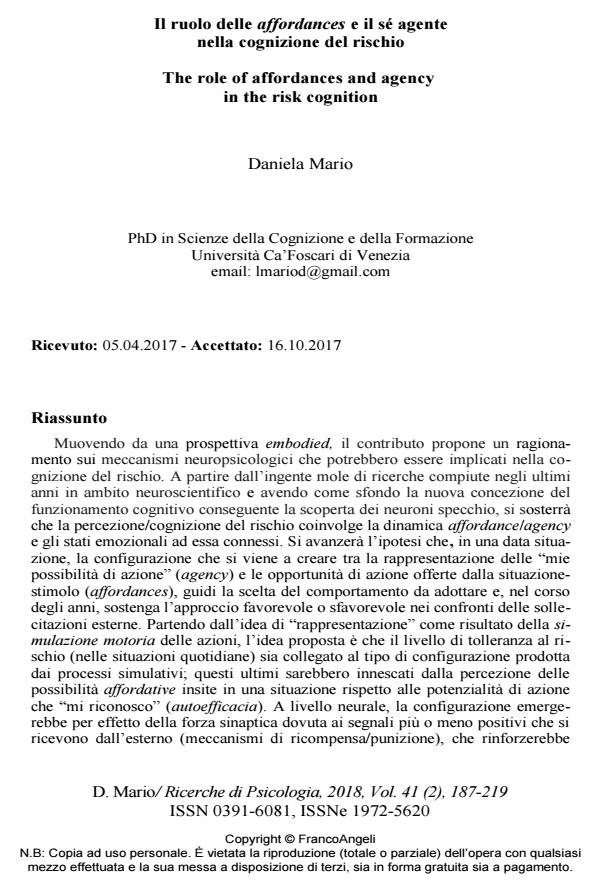The role of affordances and agency in the risk cognition
Journal title RICERCHE DI PSICOLOGIA
Author/s Daniela Mario
Publishing Year 2018 Issue 2018/2
Language Italian Pages 33 P. 187-219 File size 292 KB
DOI 10.3280/RIP2018-002001
DOI is like a bar code for intellectual property: to have more infomation
click here
Below, you can see the article first page
If you want to buy this article in PDF format, you can do it, following the instructions to buy download credits

FrancoAngeli is member of Publishers International Linking Association, Inc (PILA), a not-for-profit association which run the CrossRef service enabling links to and from online scholarly content.
This contribute follows an embodied perspective in proposing an argument about the neuropsychological mechanisms which are involved in risk cognition. Building on the extensive research which has recently been made in neuroscience thanks to the new conception of the cognitive functioning opened by the discovery of mirror neurons, I will sustain that the perception/cognition of risk involves the affordance/agency dynamic and the emotional states associated with it. My hypothesis is that, in a given situation, the configuration that is created between the representation of the individual ‘possibilities of action’ (agency) and the opportunities of action offered by the situation or stimulus (affordances) leads the choice of behaviour to be assumed and, over time, sustains the favourable or unfavourable approach to the external situation. If the ‘representation’, in the context of the embodied simulation, passes through sensory-motor simulation of actions, my idea is that the level of risk tolerance (in everyday situations) is related to the type of configuration produced by the processes of simulation. These would be triggered by the perception of opportunities of actions (affordance) which are implied in a given situation, in relation to the potentiality of action which are recognised by an individual (self-efficacy). At a neural level, the configuration would emerge by the synaptic force which is due to more or less positive signals that are received from the outside (reward/punishment mechanisms). This reinforces some connections to the detriment of others (neural Darwinism theory). How are associative schemas of affordance/agency formed? And how do the configuration/ representations that actualise the single adaptive responses emerge? What are the conditions and factors that promote the development of a relevant aptitude towards risk, to avoid the effects of both excessive propensity and aversion to risk? These are the main issue at stake in this paper that aims to formulate new possible research threads within the above mentioned conceptual framework also in the field of educational and training sciences.
Keywords: Embodied simulation, primary emotions, affordance, agency, self-efficacy.
Daniela Mario, Il ruolo delle affordances e il sé agente nella cognizione del rischio in "RICERCHE DI PSICOLOGIA " 2/2018, pp 187-219, DOI: 10.3280/RIP2018-002001